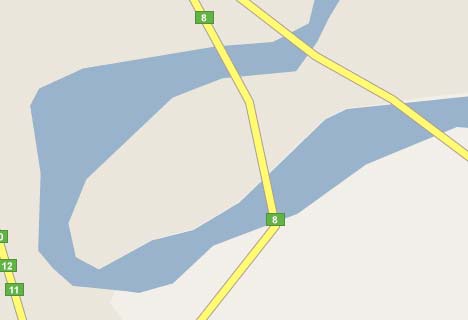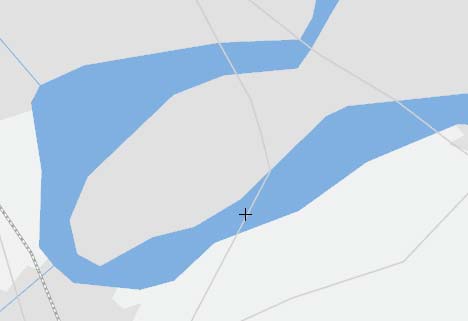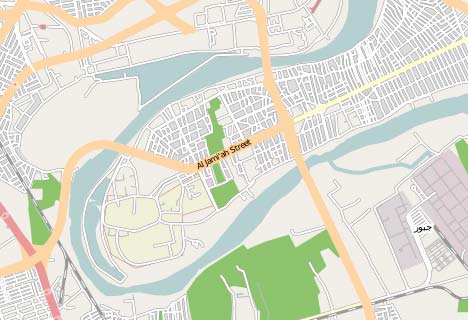- 32 Nearby Stars: On the other end of the spectrum for virtual universe visualizers, this embedded Flash-based 3D viewer of the 32 stars nearest to the Sun is cool and fun web app. (Via Bad Astronomy)
- KML Handbook: Just released, by Google senior technical writer Josie Wernecke, who also wrote Google’s own online documentation for KML 2.x. ($35 on Amazon)
- Election redux: It’s official: KML features uploaded to a Google MyMap depict fine in Second Life:

- 3D Warehouse goes 3D: You can now see 3D models using the Google Earth browser plugin, embedded right on the site, announces Google SketchUp Blog.
- Microsoft Virtual Earth gets Photosynth: One now leads to the other in selected places.
Category Archives: Uncategorized
Bhuvan: India’s upcoming web map announced, misreported
[Update 2009-08-12: Bhuvan has been launched, and is accessible here.]
Bhuvan, which means Earth in Hindu Sanskrit, will be India’s home-grown (3D?) web-based satellite imaging and mapping app when it goes live in March 2009, according to Indian media.
What it will do depends on how much faith you have in this media.
According to the Times of India it will let you “count the lions in Gir or fishermen find concentration of fish in the sea.” The Times also has nonsensical stuff like:
If Google Earth shows details upto 200 metres distance and Wikimapia upto 50 metres, Bhuvan will show images upto 10 metres, which means you can easily see details upto a three floor high building and also add information.
That’s ludicrous, of course, as it is the resolution of the camera that matters. Also, Wikimapia uses Google’s imagery, but that’s something that has been misreported before.
The Times also has what I sincerely hope is misquote by Indian Space Research Organisation chairman Dr G Madhavan Nair:
“[Bhuvan] will be able to give you an image from only 10 meters away”, he said to the excited gathering.
More believably, imagery will be updated every year, and will be of the Indian sub-continent only. The Times also reports that you’ll have the option of viewing imagery from different dates, which would indeed be a cool feature.
ExpressIndia reports, meanwhile, has what is very likely another misquote:
The ISRO Chairman said with this service they will have mapping of the entire earth, both in terms of the upper land surface and the exotic minerals down below.
That would be nice, if only it were likely to be true.
Joking aside, DNA India has a properly reported article. Salient points:
The data gathered through Bhuvan will be provided to different government agencies for urban planning, traffic management, crop planning, education and forest planning. The data will be available free to users, but very high resolution and customised precision data will be given to agencies at a cost, [ISRO Chairman] Madhavan added. “Integrated with application-specific Spatial Decision Support tools, the application will open up a new era of collaborative mapping in the country,” he said.
But I think this is unintentionally hilarious:
Technical Transfer Industrial Department head YP Rana said, “In scientific lingo, this is an oven-fresh concept, we are working on the details.
Quite possibly Rana was joking, and the reporter didn’t get the joke.
If Bhuvan turns into a web mapping resource that manages to show satellite images of all of India at a constant, say, 2.5 meter resolution, that would certainly be a worthy addition to existing web tools, complementing Google Earth’s 15m basemap with 1m DigitalGlobe imagery for urban areas. It will be especially interesting to find those parts of Bhuvan that are censored, as those are the ones we’ll all have to go check out in Google Earth for Indian military secrets.
C3’s 3D Oslo: Like bird’s eye view, but with tilt, rotate and zoom
C3, the Swedish company that brought you the automated 3D rendition of Stockholm made from just aerial shots, not LIDAR (blogged back in May) has just released a 3D version of Oslo. Wow:
(High-resolution 30MB WMV version)
The technology has gotten a lot better since May; Oslo exhibits far fewer “molten clock” artifacts, and the sides of buildings are now on the whole uniformly straight. Some errors do still creep in when it comes to vertical textures, but these are not noticeable from a casual perusal.
The overall effect is very impressive — it looks like Microsoft Virtual Earth’s bird’s eye view, except that you can rotate, tilt and zoom the view at will and keep the correct 3D perspective.
Here are a few more screenshots:



Unlike the embedded viewer used in May for Stockholm, the one used for Oslo is ActiveX-based and does not currently work in Mac and Linux browsers, though plugins for those systems are promised for early 2009. (It does work via VMWare Fusion on the Mac.)
(Some cool hints from the Norwegian instruction manual: Press P to toggle a wireframe view. I toggles rendering info, W/A/S/D is for moving, N/M for zooming, while the arrow keys tilt and rotate.)
2008 US Elections: Real live results, virtually
At the House of Sweden in Washington DC tonight, Sweden’s TV4 and associated pundits will be covering the election results live as they come in. At the Second House of Sweden, we’ve taken advantage of the fact that Second Life now supports HTML+Javascript as an object texture to provide similar functionality: We’ve turned a Google Map into a gigantic live updating billboard, showing the results:


Sure, you can embed the map on a web page, like so:
But only in Second Life can you celebrate (or commiserate) the results socially, in real time, with fellow avatars from all over the world:-) (With thanks to Tina Dahl for her help in SL)
OpenStreetMap: Your map of last resort
Google Maps’ map of Baghdad is sparse (to say the least),
Microsoft Virtual Earth isn’t much better,
And Yahoo’s is beginning to look familiar:
And yet Google Mapmaker isn’t enabled for Iraq. What to do? OpenStreetMap to the rescue!
OpenStreetMap, going where big corporate mapping datasets fear to tread.
(And when you’re done with Baghdad, check out Kabul, yet another place where Google Mapmaker isn’t enabled: Yahoo Maps, Virtual Earth, Google Maps vs. OpenStreetMap. It isn’t even close.) (Idea stolen from Aid Worker Daily, but for a good cause:-)
Virtual universes compared: Microsoft WorldWide Telescope, Celestia, Hayden’s Digital Universe
A few days ago, Microsoft Research Labs released a major beta update to their free WorldWide Telescope (Windows only). Among its many improvements, the “Autumnal Equinox” release includes a new way of exploring the universe — instead of just zooming in on photographs of the night sky as seen from Earth (as you do with Google Sky), you can now also travel through a 3D model of the Solar System, the stars in our galaxy and out past the furthest observable galaxies and quasars, giving you a fantastic view of the superstructure of the universe.
This is the first time that a 3D visualization of the furthest observable objects in the universe has been made so accessible to the casual user, for free. Similar data has been freely available for a while (for Windows, Mac, and Linux) if you know where to look. In this post I’m going to look at the state of these virtual universes, now that Microsoft has entered this application space.
Microsoft’s 3D view of the universe most clearly lends comparison to the current open-source favorite, Celestia (for Windows, Mac and Linux). It too simulates the Solar System and nearby stars, and with a bit of effort you can upload a database of around 250,000 galaxies far far away, taken from the Sloan Digital Sky Survey (SDSS). Microsoft says its galaxy database contains half a million objects, but doesn’t name the source. A third free virtual universe worth looking at is Digital Universe, by NYC’s Hayden Planetarium, a massive downloadable dataset that comes with PartiView (for Windows, Mac and Linux), its own (highly quirky) viewer.
I most want to compare the view for these three free apps from >1 gigaparsecs out, as this is where it gets to be the most mindblowing, but first let’s look at how WWT and Celestia compare on their respective renditions of the Solar System.
WWT beta’s Solar System doesn’t yet eclipse Celestia’s, which is still a much more polished piece of work for this kind of exploration. For example, check out the shadows on Saturn; Celestia doesn’t just render the shadow of Saturn on the rings, but of the rings on Saturn, unlike WWT.
Celestia:

Microsoft WorldWide Telescope:
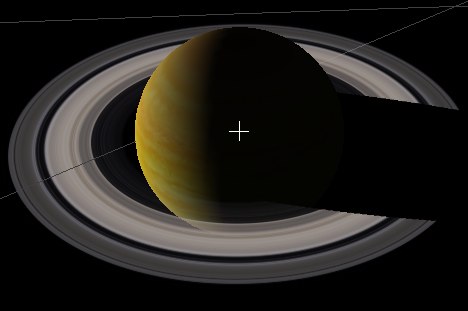
As for moons, WWT only shows our Moon and Jupiter’s four biggest ones. Celestia visualizes (with orbits and, where available, surface textures) all the Solar System’s known moon, and plenty of asteroids as well. (Minor hitch for Celestia: Saturn’s ring-hugging moons stay bathed in sunlight even as they dip into Saturn’s shadow, though I’m in not really in a position to nitpick:-)
Celestia is currently also more versatile when it comes to looking at the data — you can fly around in Celestia’s universe, as if in a virtual spaceship, at up to millions of light years per second. In WWT you are limited to choosing an object and then zooming and rotating it. Zoom all the way out from any Solar System object in WWT, and you get to see the furthest galaxies, but only ever with the Milky Way at the center of your field of view. (Celestia has other advantages too — your point of view is fully scriptable — but that’s beyond the the remit of this article.)
With WWT, however, it is easier than with Celestia to get to see the universe at scales where its superstructure is revealed. There are a few steps involved, however: First, select WWT’s new 3D viewing mode, called Solar System:
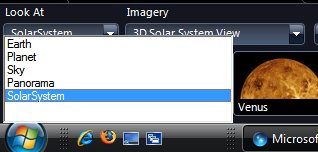
Then, download the galaxy database in WWT by checking “Cosmos” in the View menu.
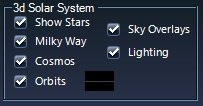
You’ll then get this ominous-sounding warning:
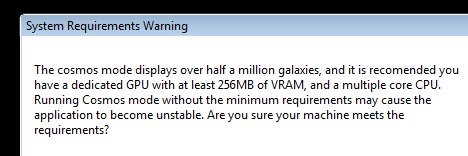
Luckily, it seemed to work fine on a friend’s year-old HP laptop. Once you have the data, start zooming out. When you get to a distance of 1 gigaparsec or more, you start seeing the filaments of galaxies that ring the voids of deep space. Here’s a quick 20 second demo of the view of Earth from 2 gigaparsecs out:
Half a million galaxies from Stefan Geens on Vimeo.
The video doesn’t do the full screen view justice. As you can see, the available data covers several slivers of the sky as seen from Earth.
If you want a similar view in Celestia, here’s what you need to do:
Once Celestia is installed, you need to find and download an extra data package at the Celestia Motherlode. The one we want is on the Extrasolar data plots page, the second version of the SDSS DR2 Galaxies dataset (ZIP file). Unzip this, and put the entire resulting folder into the Extras folder of Celestia’s CelestiaResources folder, like so:
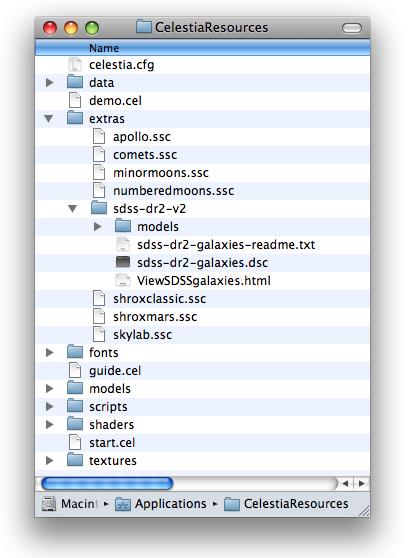
Restart Celestia. Then, not too intuitively, you need to go to Celestia’s Preference/Control panel, and make sure that the checkbox to show “Nebulae” is set, since that is what the dataset characterizes itself as to Celestia. Now Celestia too shows you the furthest observed galaxies, with the added bonus that you can make loop-de-loops through superclusters of galaxies at crazy speeds in your hypothetical spaceship.
A third approach is more data-centric. Hayden Planetarium makes its Digital Universe dataset available as a free download, together with a viewer, PartiView. (This dataset is also incorporated in a number of professional planetarium applications, such as Sweden’s SCISS AB’s UniView software. I took a video of a demo of UniView at ISDE5 in 2007).
PartiView is a strange beast. It is available for Windows, Mac, Linux and IRIX, but its rudimentary interface and affinity for command-line consoles don’t win it any beauty or usability contests. PartiView doesn’t do fancyful stuff like surface textures of planets — its one strength is the brute force rendering of constellations of particles, which is ideally suited to these kinds of extragalactic datasets. When it comes to this kind of data (of which the Sloan Digital Sky Survey is just one of several datasets available) PartiView can really put on a show:
Hayden Planetarium’s PartiView: Lots of galaxies from Stefan Geens on Vimeo.
You will need to RTFM to use PartiView, however.
To conclude: For navigating the Solar System and nearby stars, Celestia still rules, though bear in mind that WWT is beta. WWT provides the easiest path to getting a sense of the size and the composition of the visible universe (if you have Windows), while for those willing to do the work, PartiView offers the most data and can produce some beautiful results.
(For those willing to pay, Starry Night also offers a 3D simulation of the Solar System and nearby stars. I haven’t tried it.)
Egypt’s GPS ban: How does it affect the local GIS industry, Nokia and Apple’s iPhone?
Here’s an eye opener, courtesy of an article in the Daily Star Egypt:
Today, only three countries in the world still ban the commercial use of GPS: Egypt, Syria and North Korea.
And I happen to have moved to one of them.
I’d previously heard rumors that GPS was banned in Egypt, but paid no heed as I hauled my Nokia N95 and Garmin eTrex around the Western desert in the pursuit of a good blog post. It seemed outlandish to me that mass-produced consumer devices brandishing a specific chip would fall foul of a security law that is so clearly outdated. GPS was made available for civilian use in the US in 1983, and all but this trio of countries soon followed suit.
There are of course plenty of Nokia N95s and iPhones in evidence in the fashionable cafés and bars of Cairo — their absence on the local market simply increases their desirability, with places like Dubai, Beirut, London and Paris catering to demand. Nor is there any danger of arrests or mass confiscations — these GPS-enabled gadgets are owned by the sons and daughters of the country’s political and business elite.
The desert expedition industry’s dependence on GPS is also tolerated; tourism is the engine of Egypt’s economy:
GPS devices are also commonly used in desert safaris. When 19 tourists were kidnapped in the desert between Sudan and Egypt earlier this month, they used their GPS devices to inform authorities of their exact location, which facilitated the rescue operation.
So why would Egypt enact a new telecoms law as recently as 2003 that continues the ban on imports and use of GPS-equipped devices? In brief, because politics in Egypt is dysfunctional, and one of the key players is the notoriously paranoid military. For GPS use to get the green light in Egypt, all kinds of ministries as well the army would have to sign off on the law. Since these institutions are all run as fiefdoms, instead of in the best interests of the state, that isn’t going to happen, as Nokia found out:
Last June, Finnish manufacturer Nokia and the Egyptian government were in a row over the decision to ban GPS equipped phones from entering the country.
“We negotiated with the Egyptian government a lot but they insisted on their position and we aren’t responsible for illegal smuggling of banned devices,”
Eddy Rezq, Nokia regional manager, told Al-Masry Al-Youm at the time.
It is not the consumers that are the primary victim of this law — they simply pay higher prices, either on the black market or in the form of a plane ticket. (And let’s put things in perspective: The overwhelming majority of Egyptians can’t afford these phones, and are much more pre-occupied with getting food on the table than the hypothetical freedom to know their location to within five decimal places. They know where they are. And they aren’t going anywhere.)
But local GIS companies, incredibly, are officially making do without GPS:
“Because GPS is illegal, we resort to genuine methods like deploying surveyors in the streets and using satellite images,” Walaa Hassan, head of the geo data department at Dotmap, told Daily News Egypt.
“It would differ very much for our work if we were allowed to use GPS,” Hassan said
Confidence inducing, no? This is not how you develop your way out of poverty.
How should companies like Nokia and Apple respond to the legal constraints of the Egyptian market? (Garmin doesn’t have a prayer, of course:-) Nokia’s response was to not sell the offending devices, rather than release a crippled version:
“Over 40 percent of all handsets produced by Nokia within the next two years will support GPS-based applications,” [Nokia vice president and director of services and programs] Savander said, adding that it is absurd to consider changing course at this point.
“Who would regress to meet the demands of markets that refuse to keep up with progress when we’re moving at a fast pace towards developing and devising new technologies?” he added.
What about Apple? Well…
The 3G iPhone is coming soon to Egypt, as this placeholder page on Apple.com announces. Curiously, it contains no mention of the three-letter acronym GPS. If you check out a placeholder page for another country where the iPhone is pending, however, such as Jordan, the device’s GPS functionality gets a prominent airing. Here’s what Egypt’s page promises:

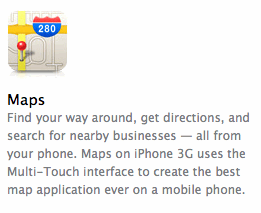
Here’s what’s Jordan’s page promises:


So is Apple readying the release of a GPS-crippled iPhone in Egypt? My hunch is yes. Would anybody here buy such a phone? Again, my hunch is yes. For the typical Egyptian user, jailbreaking the 3G iPhone is not a trivial endeavor, and using a foreign phone plan is prohibitively expensive if it is possible at all.
Intriguingly, Apple has also removed the mention of wifi- and celltower geolocation technology from its Egypt placeholder page, not just GPS. Would these functions also be crippled on the Egyptian 3G iPhone? I don’t know. Wifi- and celltower-based geolocation services by themselves would still make the Egyptian iPhone a usable location-aware device for most casual users. Without them, not so much.
But perhaps Apple is merely being clever: By selling GPS-crippled 3G iPhones in Egypt, it is carrying out its profit-maximizing duty to shareholders and yet able to blame the Egyptian government if anyone complains. (And it has occurred to me that the GPS chip is still likely to be in iPhones sold in Egypt, though turned off in firmware. That would make jailbreaking the GPS chip possible. I’m sure Apple wouldn’t mind especially.)
(Thanks Jan for the link!)
